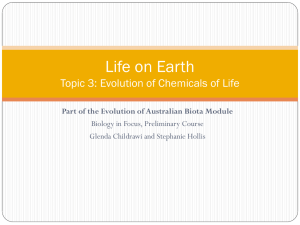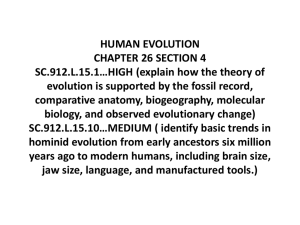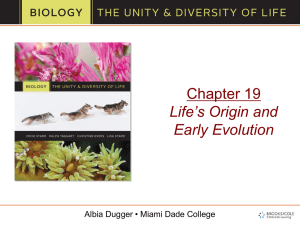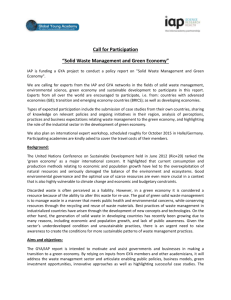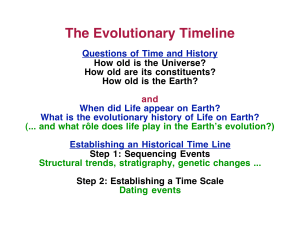The Cell Theory
advertisement
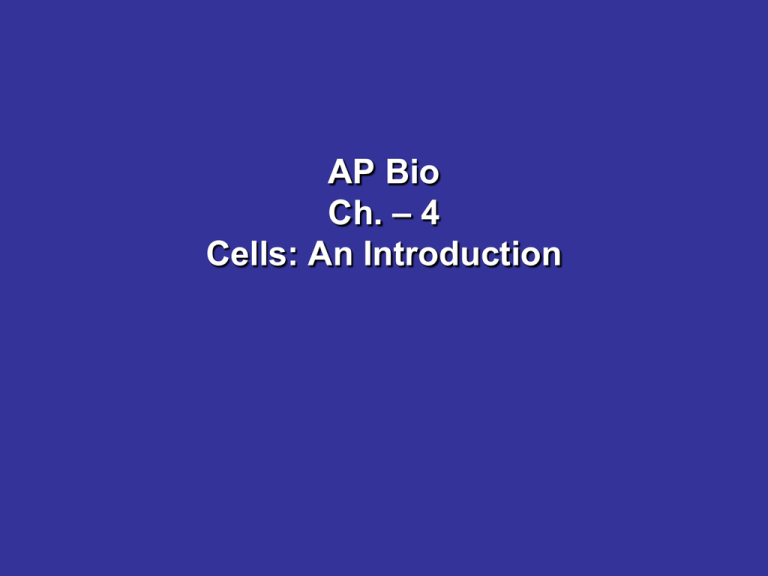
AP Bio Ch. – 4 Cells: An Introduction The Beginning of Life on Earth The first cells (life) self-assembled from molecules present in the ancient seas. Making Cells required 1. Abiotic synthesis of small organic molecules. 2. Joining of these small molecules into macromolecules. 3. Packaging these molecules into “protobionts”. 4. Self-replication. Synthesis of Organic Compounds on Early Earth Earth’s early atmosphere contained water vapor and chemicals released by volcanic eruptions (nitrogen, carbon dioxide, water and traces of methane, ammonia, and hydrogen sulfide…. C, H, O, N The necessary energy for the synthesis of organic compounds was supplied by radioactive elements, heat, electrical, and of course, the Sun’s UV radiation. The First Testable Hypothesis. A. I. Oparin hypothesized that the early atmosphere was a “reducing” environment…..and a “Chemical Evolution” was responsible for the formation of the complex molecules required for life. No atmospheric O2 could have been present… it would have destroyed and prevented the accumulation of any forming organic compounds!! In 1951 Stanley Miller and Harold Urey conducted lab experiments that showed that the abiotic synthesis of organic molecules in a reducing atmosphere is possible. Miller’s experiment only produced 5 amino acids… both right and left-handed, a racemic mixture! Instead of forming in a “reducing” atmosphere, the first organic compounds formed in the atmosphere near volcanoes and deep-sea vents. The “out-gassing” includes large amounts of CO2, H2O and Nitrogen. Stanley Miller’s Second Experiment The vials associated with the original experiment contained 5 amino acids. The 11 vials recovered from the unpublished experiment produced 22 amino acids… all left-handed. Simple modifications of the Miller experiment produce other amino acids, nucleotides and other organic compounds. Another Source of Organic Compounds • Amino acids have also been found in meteorites. Along with complex organics and Uracil…. RNA • The isotopic abundances verify extraterrestrial origin. Building Large Organic Compounds • Large organic compounds were built through Dehydration Synthesis from smaller molecules. • Structures were modified by Hydrogen bonds, polarity of individual molecules and hydrophilic, hydrophobic interactions. • Natural Selection favored the more stable compounds. Comets also contribute Organic compounds. The amino acid glycine was found in dust collected by the Stardust spacecraft, which flew by Comet Wild 2 in 2004. Other organic compounds included methanol, ethanol, and acetylene. Creating Protobionts (microspheres) Sidney Fox discovered liposomes and proteinoids form when lipids or other organic molecules are mixed with hot water. Simple reproduction by liposomes Building Protobionts The liposomes grow by absorbing other lipids and water….. They will eventually split…forming 2 vesicles…reproduction! Building Protobionts (Coacervates) Early protobionts contained abiotically produced molecules. These Protobionts, coacervates, exhibited simple reproduction, by growing and budding, simple metabolism and maintained an internal chemical environment. RNA World: Self-Replicating RNA • The first genetic material was probably RNA, not DNA. RNA molecules can: 1. Store information, and pass it on (heredity) 2. Catalyze its own replication. 3. Act as an enzyme called ribozyme which can catalyze other metabolic reactions. How to make RNA? Simple nucleotides form in water in the presence of phosphates. Organic compounds, including nucleotides polymerize, grow into chains, when they are concentrated on hot sand, clay, or rock. How “RNA World” Works A free-floating strands of RNA gets enclosed in a lipid vesicle. The protected RNA can replicate from other nucleotides. RNA forms double strands in cold water but, unwinds in warm water…transcription? External convection currents drive reproduction. As the vesicles grow and split, each carries its replicated RNA. As amino acids are added…. The ribozymes helped catalyze protein synthesis. The proteins folded into more efficient enzymes which improved replication and metabolism. Proteins, called enzymes, took over cell metabolism. RNA World: The Final Step • The Enzymes catalyze DNA formation. • DNA is more stable and can store more hereditary information. • DNA is more efficient at replication than RNA….double-stranded. • DNA takes over the cell’s protein synthesis. Why on Earth? Its distance from the Sun… the “Goldilocks” planet! Its mass… its gravity! Its Atmosphere! Heterotrophs and Autotrophs Where do cells get the energy they need to perform their life functions? Heterotrophs Heterotrophic cells are dependent upon outside sources of organic materials…these resources supply energy and the necessary components to make various cell structures. The heterotrophs include fungi, animals, some bacteria and some protists. Autotrophs Autotrophs are capable of making their own energy-rich organic compounds from available inorganic materials. There are 2 types of Autotrophs 1. Photosynthetic Autotrophs – they do not require organic compounds from the environment…they can produce them using inorganic compounds and energy from the sun…. Plants! 2. Chemosynthetic Autotrophs – capture energy through a variety of inorganic reactions… such as: 6CO2 + 6H2O + 3H2S → C6H12O6 + 3H2SO4 …..most are bacteria. The First Cells May have been heterotrophs feeding on the organic-rich “Primordial Soup”. Limited amounts of organic resources would have led to competition and the Natural Selection of the “Fittest” cells. However… If the heterotrophs were consuming all of the organic compounds…. How did they get replenished? If Autotrophs had not evolved all life would have stopped. Maybe the first cells were Chemosynthetic?….. The “Extremophiles” Extremophiles are organisms which adapted to harsh environments much like the conditions which existed on the early earth. Most Extremophiles are bacteria ….such as Methanogens, which live in anaerobic mud flats, with others living in ice sheets…. near hot, deep ocean vents and even in toxic sulfur pools. Maybe the first cells were Photosynthetic? Experiments simulating the earth’s early surface conditions and chemistry produced molecules which were the precursors of chlorophyll. When exposed to an oxygen-free environment and illuminated they produced primitive photosynthetic reactions. Today, the sun’s energy is channeled through photosynthetic autotrophs to all other life forms. The Earliest Fossils Fossils of both heterotrophs and autotrophs dating back about 3.5 billion years have been found. The Cell Theory 1665 – Robert Hooke Observed “little rooms” in cork. Coined the term "cells” in 1665. Cork Cells Anton van Leeuwenhoek (1632-1723) was the first to adapt lenses to the study of living organisms. He discovered microorganisms. 1833 - Robert Brown • Studied the nucleus. Do all living cells have a nucleus? Nucleus Human Cheek Cell 1838 - M.J. Schleiden • Botanist…. discovered all plants are made of cells. Typical Plant Cell 1839 - T. Schwann • Zoologist….discovere d animals are made of cells. • In fact Schwann believed ALL living organisms were made of cells. Nerve Cells 1855 - Rudolph Virchow “Omnis cellula e cellula” “Cells arise from pre-existing cells.” Discovered while researching cancer cells. The Cell Theory 1. All living organisms consist of one or more cells. 2. The chemical reactions of living organisms, including energy-releasing and biosynthetic reactions, takes place within cells. 3. Cells arise from pre-existing cells. 4. Cells contain hereditary information and this information is passed from parent cells to daughter cells. Prokaryotes and Eukaryotes All Cells have: 1.A Cell (Plasma) Membrane – separates the cell’s internal chemistry from the environment. 2.Self-replicating, mutable DNA – transfers genetic information from one generation to the next. 3.A Cytoplasm filled with cytosol. 4.Ribosomes – which produce structural proteins and enzymes. Packaging Your DNA Prokaryotes have circular forms of DNA, called Plasmids… or even chromosomes, which are loosely associated with structural proteins. The DNA is located in a central region called the Nucleoid. Packaging Your DNA Eukaryotes have thread-like forms of DNA, called chromosomes, which are packaged using structural proteins called histones. The DNA is located within the Nucleus which is bound by the double-membrane called the Nuclear Envelope Cell Walls 1. All Prokaryotes have cell walls. 2. Some of the Eukaryotes have cell walls… * some protista have cell walls * plants cells have cell walls * fungal cells have cell walls *** animal cells DO NOT have cell walls. Fossil records show us the first prokaryotes appeared approximately 3.5 BYA… and that The first eukaryotes appeared approximately 2.0 BYA… the origin of the eukaryotes may be explained using the “Endosymbiotic” hypothesis. Comparing the sizes of Prokaryotes and Eukaryotes In general….Eukaryotes (10 – 100 mm) are larger than prokaryotes ( 1 – 10 mm). The History of Life on Earth The geologic record is divided into four eons. Hadean: 4.5 – 3.8 Gya: Formation, oceans & atmosphere Archaean: 3.8 – 2.5 Gya: Stromatolites & fossil bacteria Proterozoic: 2.5 Gya – 454 Mya: Eukarya and Oxygen Phanerozoic: since 454 Mya: Rise of plant and animal life Hadean HadeanEon Eon The Surface begins to cool and solidify. Formation of the Oceans Formation of the Atmosphere Age of Heavy Bombardment….most events would be “sterilizing”. The Archaean Eon began with the end of heavy bombardment ~ 3.8 Gya. Conditions stabilized. Oceans, but no O2 in the atmosphere. Stromatolites appear in the geological record ~3.5 Gya and thrived for >1 Billion years. Rise of anaerobic microbes in the deep ocean & shores using Chemosynthesis. Time of rapid diversification of life driven by Natural Selection. Stromatolites in Shark Bay, Australia The Proterozoic Eon (2.5Gya – 450Mya) was the time of single-celled life and the rise of Oxygen. Find microfossils of bacteria. Emergence of Photosynthesis: First using H2S instead of H2O, so no Oxygen produced. Then using CO2+ H2O to make O2 starting ~2.4 Gya. Most of the initial Oxygen made by photosynthesis was soaked up by Banded Iron Formations (BIF’s) Major sink for early oxygen production until ~1.8 Gya. Rapid rise in atmospheric Oxygen occurred once the mineral sinks became saturated ~1.8 Gya. Crisis for anaerobic life: O2 breaks chemical bonds! Mass extinction of anaerobic bacteria except in the deep oceans and deep underground Good for emerging Aerobic life. The first Eukaryotes arose ~2.1 Gya. Biggest change in the late Proterozoic Eon ~ 580 Mya was the emergence of the multicellular life after the last Snowball Earth episode. Dickinsonia costata Soft-bodied, wormlike The Phanerozioc Eon: 450 MYA • The Cambrian Explosion in multicellular life. • Most major groups of animals and their body plans appeared rapidly at the start of the Cambrian Period 450Mya. • Complex animal and plant life quickly filled most available ecological niches.

